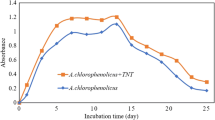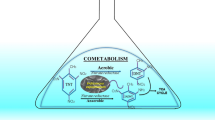Abstract
Objective
To evaluate the ability of Janibacter cremeus a soil bacterium isolated from explosive contaminated site in degradation of hexahydro-1,3,5-trinitro-1,3,5-triazine (RDX) and to study enzyme responsible for degradation.
Results
The isolate exhibited 88% degradation of RDX in 30 days of incubation. The biodegradation process followed the first order kinetics. The half- life of RDX was calculated to be 11.088 days. The RDX degradation process was complemented by concomitant release of nitrite ions with 0.78 mol of nitrite released per mole of RDX. The metabolites; Trinitroso- RDX, diamino-RDX, trimino-RDX, bis- (hydroxymethyl) nitramine and methylenedintramine derivative, viz, methylene- N- (hydroxy- methyl)- hydroxylamine- N-(hydroxymethyl) nitroamine corresponding to the molecular weights 174, 162, 132, 122 and 167 Da respectively were also detected. Nitroreductase enzyme was found to be responsible for RDX degradation.
Conclusion
J. cremeus could degrade RDX as sole source of nitrogen, via three different pathways wherein, Nitroreductase enzyme was found to play a major role. The efficient degradation of RDX makes J. cremeus suitable in treatment of contaminated water and soil at field scale levels.








Similar content being viewed by others
Abbreviations
- ln :
-
Natural logarithm
- k :
-
Rate constant
References
Arnett CM, Adrian NR (2009) Co-substrate independent mineralization of hexahydro-1,3,5-trinitro-1,3,5-triazine (RDX) by a Desulfovibrio species under anaerobic conditions. Biodegradation 20:15–26. https://doi.org/10.1007/s10532-008-9195-1
Bhatt M, Zhao JS, Halasz A, Hawari J (2006) Biodegradation of hexahydro-1,3,5-trinitro-1,3,5-triazine by novel fungi isolated from unexploded ordnance contaminated marine sediment. J Ind Microbiol Biot 33(10):850–858. https://doi.org/10.1007/s10295-006-0136-x
Binks PR, Nicklin S, Bruce NC (1995) Degradation of hexahydro- 1,3,5-trinitro-1,3,5-triazine (RDX) by Stenotrophomonas maltophilia PB1. Appl Environ Microbiol 61:1318–1322
Coleman NV, Nelson DR, Duxbury T (1998) Aerobic biodegradation of hexahydro-1,3,5-trinitro-1,3,5-triazine (RDX) as a nitrogen source by a Rhodococcus sp., strain DN22. Soil Biol Biochem 30:1159–1167. https://doi.org/10.1016/S0038-0717(97)00172-7
Crocker FH, Indest KJ, Fredrickson HL (2006) Biodegradation of the cyclic nitramine explosives RDX, HMX, and CL-20. Appl Microbiol Biotechnol 73:274–290. https://doi.org/10.1007/s00253-006-0588-y
Cupples AM (2013) RDX degrading microbial communities and the prediction of microorganisms responsible for RDX bioremediation. Int Biodeter Biodegr 85:260–270. https://doi.org/10.1016/j.ibiod.2013.08.002
Environmental Protection Agency (2006) Method-8330B (SW-846): nitroaromatics, nitramines, and nitrate esters by high performance liquid chromatography (HPLC). U.S, Environmental Protection Agency Washington, DC
Environmental Protection Agency (2011) Edition of the drinking water standards and health advisories. EPA 820-R-11–002. Office of Water U.S. Environmental Protection Agency Washington, DC
Fournier D, Halasz A, Spain JC, Fiurasek P, Hawari J (2002) Determination of key metabolites during biodegradation of hexahydro-1,3,5- trinitro—1,3,5-triazine with Rhodococcus sp. strain DN22. Appl Environ Microbiol 68:166–172. https://doi.org/10.1128/AEM.68.1.166-172.2002
Hamada M, Shibata C, Tamura T, Yamamura H, Hayakawa M, Suzuki K (2013) Janibacter cremeus sp. nov., an actinobacterium isolated from sea sediment. Int J Syst Evol Microbiol 63:3687–3690. https://doi.org/10.1099/ijs.0.051532-0
Hawari J, Halasz A, Sheremata T, Beaudet S, Groom C, Paquet L, Rhofir C, Ampleman G, Thiboutot S (2000) Characterization of metabolites during biodegradation of hexahydro-1,3,5-trinitro- 1,3,5-triazine (RDX) with municipal anaerobic sludge. Appl Environ Microbiol 66:2652–2657. https://doi.org/10.1128/AEM.66.6.2652-2657.2000
Khessairi A, Fhoula I, Jaouani A, Turki Y, Cherif A, Boudabous A, Hassen A, Ouzari H (2014) Pentachlorophenol degradation by Janibacter sp., a new actinobacterium isolated from saline sediment of arid land. BioMed Res Int. https://doi.org/10.1155/2014/296472
Kitts CL, Cunningham DP, Unkefer PJ (1994) Isolation of three hexahydro-1,3,5-trinitro-1,3,5-triazine-degrading species of the family Enterobacteriaceae from nitramine explosive-contaminated soil. Appl Environ Microbiol 60:4608–4611
Kitts CL, Green CE, Otley RA, Alvarez MA, Unkefer PJ (2000) Type I nitroreductases in soil enterobacteria reduce TNT (2,4,6-trinitrotoluene) and RDX (hexahydro-1,3,5-trinitro-1,3,5-triazine). Can J Microbiol 46:278–282. https://doi.org/10.1139/w99-134
McCormick NG, Cornell JH, Kaplan AM (1981) Biodegradation of hexahydro-1,3,5-trinitro-1,3,5-triazine. Appl Environ Microbiol 42:817–823
Mercimek HA, Dincer S, Guzeldag G, Ozsavli A, Matyar F (2013) Aerobic biodegradation of 2,4,6-Trinitrotoluene (TNT) by Bacillus cereus isolated from contaminated soil. Microb Ecol 66:521–521. https://doi.org/10.1007/s00248-013-0248-6
Nagar S, Shaw AK, Anand S, Celin SM, Rai PK (2018) Aerobic biodegradation of HMX by Planomicrobium flavidum. 3 Biotech. https://doi.org/10.1007/s13205-018-1479-5
Oh SY, Chiu PC, Kim BJ, Cha DK (2003) Enhancing Fenton oxidation of TNT and RDX through pre-treatment with zero-valent iron. Water Res 37:4275–4283. https://doi.org/10.1016/S0043-1354(03)00343-9
Roh H, Yu CP, Fuller ME, Chu KH (2009) Identification of hexahydro-1,3,5- trinitro-1,3,5-triazine-degrading microorganisms via 15N-stable isotope probing. Environ Sci Technol 43:2505–2511. https://doi.org/10.1021/es802336c
Roldán MD, Pérez-Reinado E, Castillo F, Moreno-Vivián C (2008) Reduction of polynitroaromatic compounds: the bacterial nitroreductases. FEMS Microbiol Rev 32:474–500. https://doi.org/10.1111/j.1574-6976.2008.00107.x
Seth-Smith HMB, Edwards J, Rosser SJ, Rathbone DA, Bruce NC (2008) The explosive-degrading cytochrome P450 system is highly conserved among strains of Rhodococcus spp. Appl Environ Microb 74:4550–4552. https://doi.org/10.1128/aem.00391-08
Singh B, Kaur J, Singh K (2011a) 2,4,6-Trinitrophenol degradation by Bacillus cereus isolated from a firing range. Biotechnol Lett 33:2411–2415. https://doi.org/10.1007/s10529-011-0726-1
Singh S, Kang SY, Mulchandani A, Chen W (2011b) Bioremediation: environmental clean-up through pathway engineering. Curr Opin Biotech 19:437–444. https://doi.org/10.1016/j.copbio.2008.07.012
Solyanikova IP, Baskunov BP, Baboshin MA, Saralov AI, Golovleva LA (2011) Detoxification of high concentrations of trinitrotoluene by bacteria. Appl Biochem Microbiol 48:21–27. https://doi.org/10.1134/S0003683812010152
Van Aken B, Yoon JM, Schnoor JL (2004) Biodegradation of nitro-substituted explosives 2,4,6-trinitrotoluene, hexahydro-1,3,5-trinitro-1,3,5-triazine, and octahydro-1,3,5,7-tetranitro-1,3,5-tetrazocine by a phytosymbiotic Methylobacterium sp. associated with poplar tissues (populus deltoides x nigra DN34). Appl Environ Microb 70(1):508–517. https://doi.org/10.1128/aem.70.1.508-517.2004
Villanueva JR (1959) Interference by azide with diazotization procedures used in biological assay systems. Nature 184:549–549. https://doi.org/10.1038/184549a0
Yadav S, Sharma A, Khan MA, Sharma R, Celin M, Malik A, Sharma S (2020) Enhancing hexahydro-1, 3, 5-trinitro-1, 3, 5-triazine (RDX) remediation through water-dispersible Microbacterium esteraromaticum granules. J Environ Manag 264:110446. https://doi.org/10.1016/j.jenvman.2020.110446
Young DM, Kitts CL, Unkefer PJ, Ogden KL (1997a) Biological breakdown of RDX in slurry reactors proceeds with multiple kinetically distinguishable paths. Biotechnol Bioeng 56:258–267
Young DM, Unkefer PJ, Ogden KL (1997b) Biotransformation of hexahydro-1,3,5-trinitro-1,3,5-triazine (RDX) by a prospective consortium and its most effective isolate Serratia marcescens. Biotechnol Bioeng 53:515–522
Zhang C, Hughes JB (2003) Biodegradation pathways of hexahydro- 1,3,5-trinitro-1,3,5-triazine (RDX) by Clostridium acetobutylicum cell-free extract. Chemosphere 50:665–671. https://doi.org/10.1016/S0045-6535(02)00639-2
Zhao JS, Greer CW, Thiboutot S, Ampleman G, Hawari J (2004) Biodegradation of the nitramine explosives hexahydro-1,3,5-trinitro-1,3,5-triazine and octahydro- 1,3,5,7-tetranitro-1,3,5,7-tetrazocine in cold marine sediment under anaerobic and oligotrophic conditions. Can J Microbiol 50:91–96. https://doi.org/10.1139/w03-112
Acknowledgements
Authors wish to thank Sh. Rajiv Narang, OS and Director and R.K Tanwar of Centre for Fire Explosive and Environment Safety (CFEES) DRDO for their constant support and encouragement. The authors would also like to thank Dr. S. Mayil Raj and Dr. S. Krishnamurthi, IMTECH, Chandigarh for isolation and identification of culture.
Supporting information
Online Resource 1—Media composition.
Online Resource 2—Analysis of nitrite released.
Funding
This work was supported by Centre for Fire, Explosive and Environment Safety (CFEES), Defense Research and Development Organization, India.
Author information
Authors and Affiliations
Corresponding author
Ethics declarations
Conflict of interest
All the authors declare that they have no conflict of interest.
Ethical approval
This article does not contain any studies with human participants or animals performed by any of the authors.
Additional information
Publisher's Note
Springer Nature remains neutral with regard to jurisdictional claims in published maps and institutional affiliations.
Electronic supplementary material
Below is the link to the electronic supplementary material.
Rights and permissions
About this article
Cite this article
Kalsi, A., Celin, S.M. & Sharma, J.G. Aerobic biodegradation of high explosive hexahydro-1,3,5- trinitro-1,3,5-triazine by Janibacter cremeus isolated from contaminated soil. Biotechnol Lett 42, 2299–2307 (2020). https://doi.org/10.1007/s10529-020-02946-6
Received:
Accepted:
Published:
Issue Date:
DOI: https://doi.org/10.1007/s10529-020-02946-6




